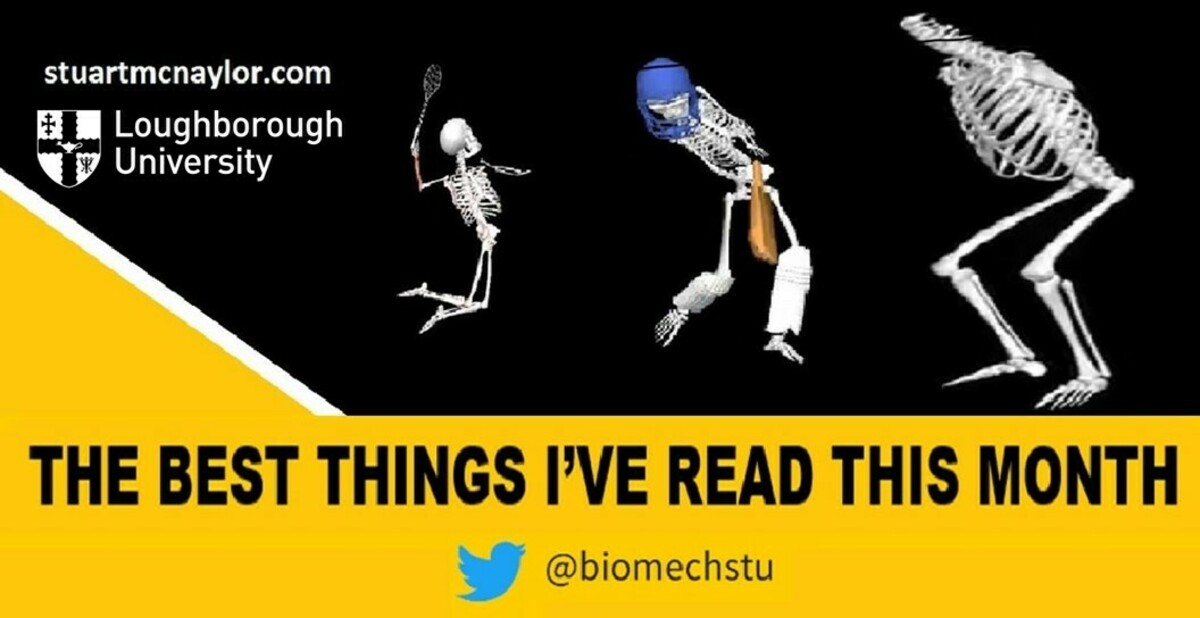
Welcome to my monthly update.
There are two sections: ‘What Have I Been Up To?’ and ‘What Have I Been Reading?’
Here’s what I would like to share with you this month…
What Have I Been Up To?
Free resources for academia: I recently updated the list of useful free resources on my website. The resources are split into categories such as time management or social media through to various stages of the research process such as data visualisation or scientific writing. Please share the resources with anybody you feel may benefit.
PhD opportunity: As mentioned a couple of months ago, we are recruiting a PhD student for the Badminton World federation funded project ‘The Development and Application of an Open-Source Badminton-Specific Training Load Metric’. The advert is now available here . Please get in touch if you wish to discuss the project further.
Visual3D Tutorial: My most recent YouTube tutorial (below) demonstrates how to scale the colour of body segments inVisual3D to variables including ground reaction force, segmental angular velocity, and any other calculated variable or parameter. Additionally, how to add 3D equipment and clothing into the skeletal graphics and visualisations. I’ve found free3d.com to be really useful for 3D object files (e.g. sporting equipment), but C-Motion have also recommended turbosquid.com which looks good. Each week, I’ll be posting some videos of my biomechanics and research methods teaching so please consider subscribing to the channel to keep updated.
Flywheel training: Kevin de Keijzer published the first study from his PhD : a survey detailing the perceptions and applications of flywheel training by 51 professional soccer practitioners. For a quick overview, there is a video summary or a Twitter thread . Related to this, my recent keynote lecture on ‘Biomechanical Considerations for Flywheel resistance Exercise’ is now available on YouTube.
What Have I Been Reading?
Now for the main part of the newsletter…
Using biomechanical feedback: In this paper , Paul Glazier argues that biomechanical feedback can describe an athlete’s current patterns of coordination and control, but cannot prescribe how these patterns should be modified to enhance performance (a topic we previously covered in relation to simulation modeling). Instead, he suggests that the data be used to channel the athlete’s search towards their own unique ‘optimum’ pattern as they actively explore their perceptual-motor workspace during practice. A related systematic review recently compared knowledge of performance and knowledge of results for promoting motor skill learning.
Data normalisation: Do you normalise your biomechanical data (or any other data) by dividing by another variable such as body mass?If so, then you’ll probably want to read through a couple of recent Twitter threads. The first (actually from a while ago) covers some assumptions such as linear relationships that pass through the origin, as well as consequences for data normality. The second thread provides a bit more statistical insight into these considerations. On the topic of normalisation, this short communication article discusses the various alternative methods for temporally aligning data (e.g. to 0-100% of a movement).
Relative muscular effort during squats: I really liked the way this paper combined experimental and theoretical approaches. They used a musculoskeletal model to determine relative muscular effort during back squats ans split squats, accounting for force-length-velocity properties. A short Twitter thread summary of the paper is also available.
Linking the CMJ force-time curve to performance: This paper used an objective classification of countermovement jump ground reaction force profile (e.g. uni- or bimodal, early or late peak, high to low or low to high) to explore relationships with performance measures including jump height and modified reactive strength index (RSImod). RSImod, but not jump height or take-off momentum, was greater in unimodal jumps, whereas take-off momentum and RSImod were both greater when peak force occurred early in the concentric phase.
Biomechanics history: As with some of the items mentioned last month , I love to get an insight into the history of our discipline. This month, a couple of old extracts surfaced online. The first was the proceedings of the American Society of Biomechanics’ 1st annual meeting in 1977. One example mentioned the need for sports biomechanics to move beyond centre of gravity analyses and assess individual body segments. The second extract, shared by Ross Miller, described the 500 man-hours required to perform 3D inverse dynamics calculations in 1950.
Thank You
That’s all for this month. If you found it useful, please forward this email or share this link with friends, colleagues, or on social media.
What Have You Read Recently?
If you’ve read anything particularly interesting or useful recently, please reply to this email and let me know. I read all of the replies and I’m always looking for good reading suggestions.
Take care, and thank you for reading.
Stuart